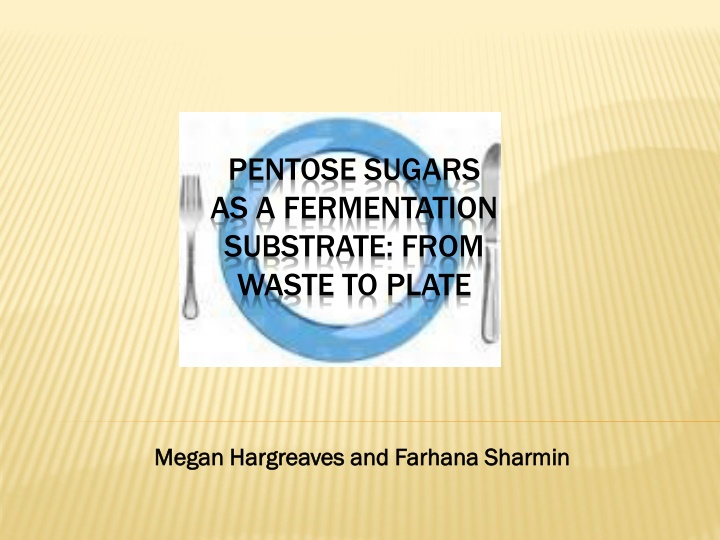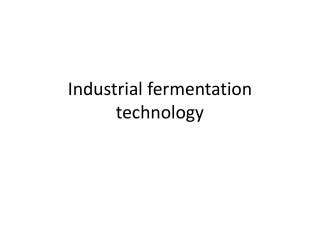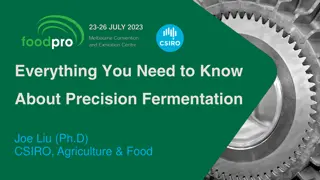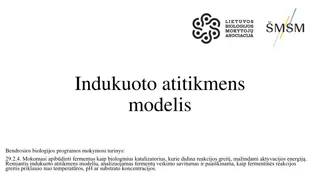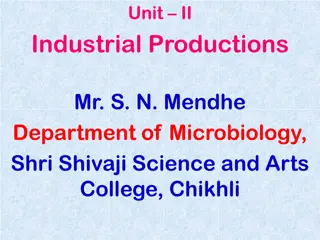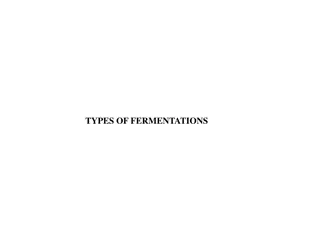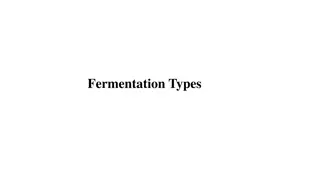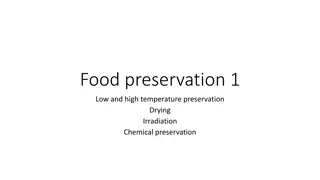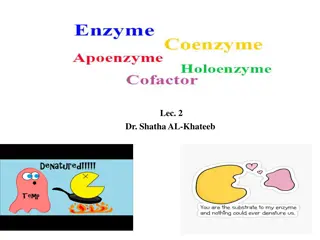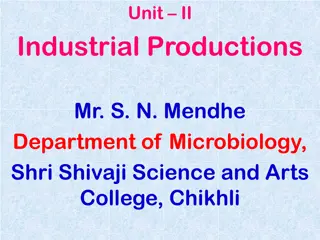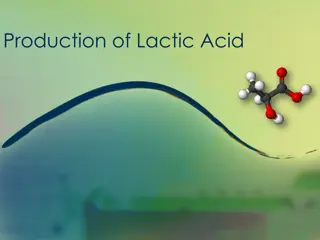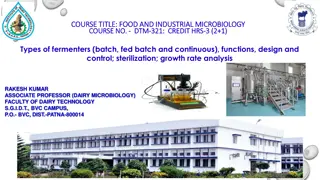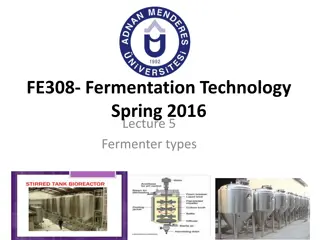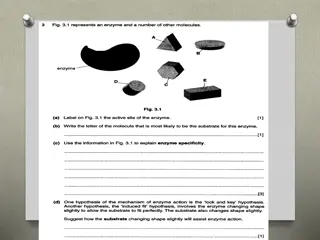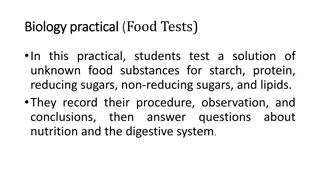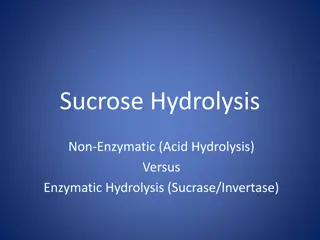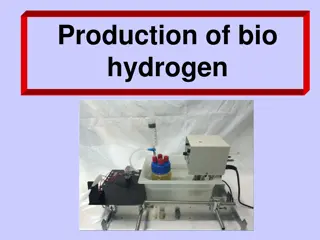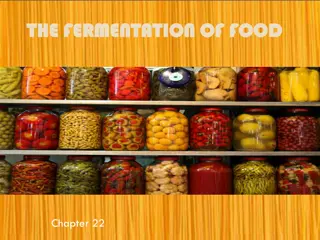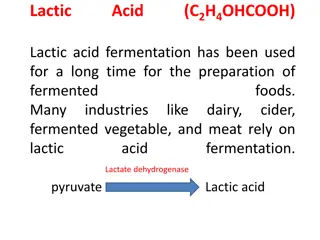Potential of Pentose Sugars as Fermentation Substrate
Plant cell walls consist of cellulose and hemicellulose, which include various pentose sugars like xylose, mannose, galactose, and more. These sugars can be used as fermentation substrates, leading to the production of biofuels and other valuable products. Methods to utilize pentose sugars effectively involve searching for specialized microbes, implementing efficient diauxie processes, and enhancing selective fermentation of hemicellulose pentoses while overcoming inhibitory factors. The use of bagasse, a byproduct of sugar cane processing, demonstrates the sustainable utilization of these sugars for various applications.
Download Presentation

Please find below an Image/Link to download the presentation.
The content on the website is provided AS IS for your information and personal use only. It may not be sold, licensed, or shared on other websites without obtaining consent from the author.If you encounter any issues during the download, it is possible that the publisher has removed the file from their server.
You are allowed to download the files provided on this website for personal or commercial use, subject to the condition that they are used lawfully. All files are the property of their respective owners.
The content on the website is provided AS IS for your information and personal use only. It may not be sold, licensed, or shared on other websites without obtaining consent from the author.
E N D
Presentation Transcript
http://t3.gstatic.com/images?q=tbn:ANd9GcTCiLA7-sXjI7L-tiZsc0sP_yHt7WPlxHbOBR2nfYFba8rwurVyAl9LYAuShttp://t3.gstatic.com/images?q=tbn:ANd9GcTCiLA7-sXjI7L-tiZsc0sP_yHt7WPlxHbOBR2nfYFba8rwurVyAl9LYAuS PENTOSE SUGARS AS A FERMENTATION SUBSTRATE: FROM WASTE TO PLATE Megan Hargreaves and Farhana Sharmin Megan Hargreaves and Farhana Sharmin
SOURCE AND USES OF BAGASSE https://encrypted-tbn0.gstatic.com/images?q=tbn:ANd9GcSydtr5o4i-gsxxk1Y_2U54h5VpRZjKuBAUpx_DEQ7IlILH3VDYPh_leXs Particle Particle https://encrypted-tbn1.gstatic.com/images?q=tbn:ANd9GcThC-cDvyODe3fiw8JWJA_FkMVxyw5ku58k_-Xn1CQvsbj7CTwqeJDYNTc board board Sugar Cane Sugar Cane https://encrypted-tbn1.gstatic.com/images?q=tbn:ANd9GcQIet89Mt4RnkgE4zrX6lTCCzCGrKSpF28n8tHnHIowOI_rzpXD4-rg0C8 https://encrypted-tbn0.gstatic.com/images?q=tbn:ANd9GcRbMpwjuiH9d561GGhkq5hthUb23DoLTxLKYUivzQSpPIaKedScpY9JUIw Bagasse Bagasse Bagasse Power Power https://encrypted-tbn1.gstatic.com/images?q=tbn:ANd9GcTy5Zxlus03Ii2jbDQkzECb0Ki3wr2_Pa6v-AI9qsjFGkO1WfMOWNhcg70 Sugar and Sugar and sugar sugar https://encrypted-tbn0.gstatic.com/images?q=tbn:ANd9GcQNlJzJUgXxtfs-fjSIYVVRG3rgdm7e-sEyaFGI8lVrT4-x1MjYDCawQfQ Sugar and sugar products products products Disposable Disposable tableware tableware https://encrypted-tbn1.gstatic.com/images?q=tbn:ANd9GcS03w9plNjrBzfn5t7WvSdwTmFpXwNr-mEMbzck4a6YaUzf8-xNjC6_S_P0Sw Paper Paper https://encrypted-tbn2.gstatic.com/images?q=tbn:ANd9GcRO2k04xzBr7Waybeg369CPMbkZG40HE80R77TyO306GFWIzIDQvhSuYg Furfural Furfural and and products products Hemicelluloses Hemicelluloses ???????????? ????????????
HEMICELLULOSES Plant cell walls are composed of cellulose and hemicellulose, pectin and in many cases lignin Hemicelluloses include xylan, glucuronoxylan, arabinoxylan, glucomannan and xyloglucan. These polysaccharides contain many different sugar monomers. Besides glucose, sugar monomers in hemicellulose can include xylose, mannose, galactose, rhamnose and arabinose Hemicelluloses contain mostly D-pentose sugars, and occasionally small amounts of L-sugars as well. Xylose is in most cases the sugar monomer present in the largest amount http://www.scidacreview.org/0905/html/biofuel.html
https://encrypted-tbn2.gstatic.com/images?q=tbn:ANd9GcR0NM5srbVdzd-TVgLnLs5LsCRfECe7hVl84-imAt9rvKVjxayjKmA97Qhttps://encrypted-tbn2.gstatic.com/images?q=tbn:ANd9GcR0NM5srbVdzd-TVgLnLs5LsCRfECe7hVl84-imAt9rvKVjxayjKmA97Q USING PENTOSE SUGARS Search for microbes that can Metabolise the pentoses in the presence of glucose, preferably without being subject to catabolite repression OR Carry out an efficient diauxie process using two or more sugars sequentially OR Form a sequential process involving a number of microbial processes to enhance the selective fermentation of hemicellulose pentoses Resist inhibition by other end-products such as hydroxymethylfurfural
TEST AREA - BACKGROUND More than 6 300 sugar growing families own and operate farms along Queensland's east coast. Farms range in size from 20 to 250 hectares, average size is 65 hectares. Queensland's east coast has the right conditions for growing sugar cane which needs: At least 1 500mm of rain each year or access to irrigation Temperatures over 21 degrees Celsius while growing Flat to gently sloping land Fertile and well drained soil. http://www.rochedalss.eq.edu.au/sugar.htm
EXPERIMENTAL DESIGN Search for test cultures Isolate pentose sugar utilizing bacteria from soil samples in sugar mill areas Identify isolates using DNA technology Testing of Isolates for growth with pentose and hexose sugars Analysis of end-products following utilization of single and dual sugar carbon sources
THE SEARCH Soils from areas surrounding sugar mill waste ponds were collected from the Maryborough and Proserpine sugar mills Bacterial strains were isolated from soil samples by means of a series of enrichment steps - broths containing one of 0.5% xylose or arabinose or ribose Six cultures of interest from 191 isolates, from the two different sites
IDENTITY OF TARGET ISOLATES DNA analysis was performed in order to confirm the identity of the isolated species Isolates were identified as Corynebacterium glutamicum (x2) Actinomyces odontolyticus (x2) Nocardia elegans Propionibacterium freudenreichii All are known soil organisms and all members of the Order Actinomycetales
GROWTH WITH PENTOSE SUGAR CARBON SOURCES Corynebacteria cystitidis PC1-2 (C.glutamicum) 3 2.5 2.5 2 2 1.5 OD680 OD680 1.5 1 1 0.5 0.5 0 24 36 48 60 72 84 96 0 0 12 24 36 48 60 72 84 96 TIME LBX LBX TIME LBG LBG 31TG (P. freudenreichii) 2.5 2 1.5 OD680 1 0.5 0 24 36 48 60 72 84 96 LBA TIME LBG
SUMMARY OF GROWTH FIGURES Results showed that the six indigenous isolates, PC4-1 and NC1-3 (A. odontolyticus), PC1-2 and NC1-2 (C. glutamicum), NC4-1 (N. elegans) and 31TG (P. freudenreichii), could utilize various pentoses and also glucose The specific growth rates ( ) of all organisms using pentoses and glucose were calculated There was very little significant difference between specific growth rates using the three pentose sugar carbon sources A significant difference was found between utilization of xylose and glucose by all of the environmental isolates and the ATCC control
END PRODUCT ANALYSIS The analysis was performed using two identical Agilent 1100 HPLC (Heracles, Japan) systems. Each system consisted of a binary pump, a UV detector, a fluorescence detector and an auto sampler. A reverse phase Agilent Zorbax Eclipse C18 column AAA (4.6150 mm, 3.5 micron) was used for the chromatographic separation. Amino acid end Amino acid end- -products using single and dual carbon sources as substrates products using single and dual carbon sources as substrates Isolate Amino acid from single sugar substrate Threonine Arginine Cysteine Arginine Cysteine Glycine Arginine Cysteine Glycine Alanine Concentration mg/L Amino acid from dual sugar substrate Glycine Glycine Concentration mg/L 36 45 6 46 3 5 47 10 5 6 22 22 22 22 N. elegans (NC4-1) A. odontolyticus (PC4-1, NC1-3) C. glutamicum (NC1- 2, PC1-2)) Glycine Glycine P. freudenreichii (31TG)
SIGNIFICANCE OF END-PRODUCTS Major product of dual-sugar fermentation was amino acid glycine Simplest amino acid Is becoming known for many medical/nutritional uses protects against shock caused either by blood loss or endotoxin reduces alcohol levels in the stomach improves recovery from alcoholic hepatitis diminishes liver injury caused by hepatotoxic drugs blocks programmed cell death reduces the nephrotoxicity caused by the drug cyclosporin A in the kidney, preventing hypoxia and free radical formation. could be also useful in other inflammatory diseases since it diminishes cytokine production.
CONCLUSIONS Six indigenous bacteria were isolated and identified from the environment, and were able to use pentose sugars without any genetic modification The isolates were able to utilize pentoses in the presence of glucose The fermentation process resulted in a valuable commercial product, namely the amino acid glycine Optimization of growth media and conditions will be necessary to increase the efficiency of the process and the size of the yield
REFERENCES US dept of Energy, SCIDAC Review. http://www.scidacreview.org/0905/html/biofuel.html Ajinomoto (on-line, accessed 2/07/2014). Amino Acid Technologies. http://www.ajiaminoscience.com/products/manufactured_products/l-amino_acids/glycine.aspx Guillaume-Signoret, M. (2006) Developing uses for sugar-cane bagasse: Biotechnology applied to the paper industry. Public release, guillaum@paris.ird.fr, 33-014-803-7607 Institut de recherche pour le d veloppement Gundersen, R. Y., Vaagenes, P., Breivik, T., Fonnum, F. and Opstad, P. K. 2005. "Glycine an important neurotransmitter and cytoprotective agent". Acta Anaesthesiologica Scandinavica 49 (8): 1108-1116. Heimbuch, J., (2008),India Exploring the Many Uses of Sugarcane Waste. Online at Ecogeek.org, accessed on 30/06/14. Lin, Y. and Tanaka, S. (2006). "Ethanol fermentation from biomass resources: Current state and prospects". Applied Microbiology and Biotechnology 69 (6): 627-642. Matilla B1, Mauriz JL, Culebras JM, Gonz lez-Gallego J, Gonz lez P. (2002). Glycine: a cell-protecting anti- oxidant nutrient. Nutr Hosp. 2002 Jan-Feb;17(1), Pps 2-9. Paturau, J.M. (accessed online, 30/06/14). Alternative uses of sugarcane and its byproducts in agroindustries. Food and Agriculture Organization of the United Nations Document Repository. Satyanarayana, K.G., Arizaga, G.G.C., Wypych,. F. (2009). Biodegradable composites based on lignocellulosic fibers An overview. Progress in Polymer Science, Volume 34, Issue 9, September 2009, Pages 982 1021 U.S.Department of Energy. (2005). "Biofuels joint roadmap". Biomass to Biofuels Workshop, December 7 9, 2005, Rockville, Maryland. . Womersley, J. (2006). Guideline: Managing impacts from the bulk storage of bagasse. Department of Environment and Resource Management publication, Queensland, Australia.
